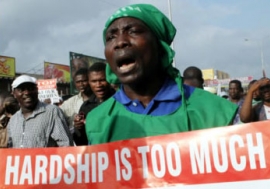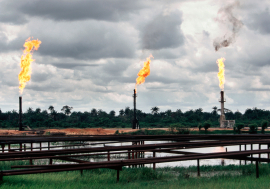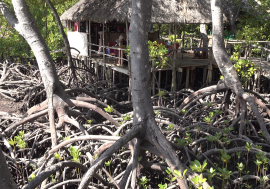Climate deal: hard work lies ahead
Climate deal: hard work lies ahead
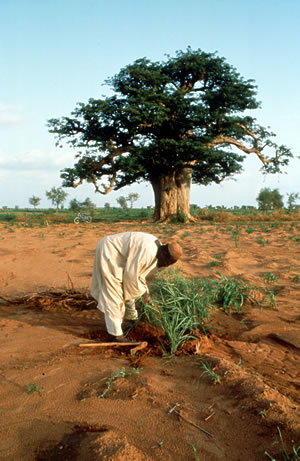
A farmer in Burkina Faso, one of many countries in Africa suffering from more severe water shortages
and other effects of climate change.
It was not the agreement that anyone had wanted. But during the night of 18–19 December — as nearly two weeks of contentious talks tottered on the brink of collapse — a limited deal was finally brokered among a couple dozen leaders, out of the nearly 120 governments that sent delegations to the United Nations climate change conference.
Reflecting the often chaotic and messy negotiating process, when the text was presented to the rest of the presidents, ministers and other delegates, a few developing countries rejected the three-page Copenhagen Accord, named after the Danish capital that hosted the conference. That opposition prevented the conference as a whole from reaching the consensus needed for outright approval, so instead it officially agreed to “take note” of the agreement. But the major industrialized powers, as well as China, Africa, the least developed countries and numerous others, supported it, some grudgingly and many with reservations.
“We wanted a complete, legally binding agreement,” said South African President Jacob Zuma, expressing the views of many delegates, “but accept the progress that has been made.” UN Secretary-General Ban Ki-moon acknowledged that “the Copenhagen Accord may not be everything that everyone hoped for.” However, he emphasized, “it is a beginning — an essential beginning.”
For Africa specifically, the agreement was significant in two respects. First, for the actual elements of the accord. And second, for Africa’s strong presence throughout the talks. Africa often finds itself on the margins of such international negotiations and usually is excluded from backroom bargaining. But in this case several African leaders, most notably President Zuma and Ethiopian Prime Minister Meles Zenawi, actively helped hammer out the final terms.
Limiting greenhouse emissions
Months before the Copenhagen meeting, many governments and environmental activists had aimed for a new international agreement to succeed the 1997 Kyoto Protocol, which expires in 2012. That protocol obligates participating industrialized countries to significantly reduce their emissions of the polluting “greenhouse” gases that contribute to global warming. Since the US is not part of the Kyoto Protocol, and China and other “emerging economies” that also produce large amounts of such gases were not required to reduce their emissions, many had hoped to bring them into a new and legally-binding accord, with specific targets for drastic emissions cuts.
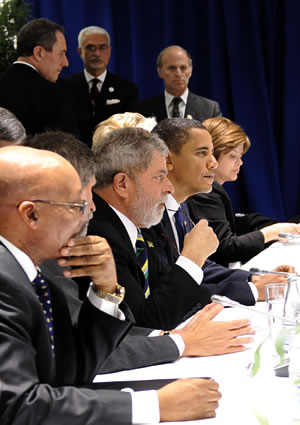 South African President Jacob Zuma (left), sitting next to Brazilian President Luis Inácio Lula da Silva and US President Barack Obama, during a negotiating session at the climate change conference in Copenhagen. Africa played a prominent and influential role in the talks.
South African President Jacob Zuma (left), sitting next to Brazilian President Luis Inácio Lula da Silva and US President Barack Obama, during a negotiating session at the climate change conference in Copenhagen. Africa played a prominent and influential role in the talks.Photograph: Associated Press / Susan Walsh
But as the meeting approached, it became increasingly clear that there was not enough support for such an agreement. The Copenhagen Accord instead expressed a “strong political will” to combat climate change, through “deep cuts in global emissions” that would hold the increase in the average global temperature below 2 degrees Celsius, compared with its pre-industrial level (it is now at about 1 degree). Industrialized and developing countries were encouraged, individually, to spell out what emissions cuts and other efforts they would make to contribute to that goal.
Besides noting the absence of precise, mandatory targets, a number of critics of the accord also questioned the 2-degree limit. Lumumba Di-Aping of Sudan, who served as coordinator of the developing countries’ Group of 77, maintained that allowing global temperatures to rise even that much was tantamount to a “suicide pact.” Most African representatives did not share that belief.
For their part, delegates from small island developing states pressed for a limit of 1.5 degrees, arguing that anything more would permit an alarming rise in sea levels and thereby threaten their very survival. The Copenhagen Accord acknowledges that a 2-degree limit may not be sufficient, and calls for a reassessment of the target by 2015.
Whatever the agreement’s shortcomings, many delegates saw the willingness of the US, China and other countries to be part of the Copenhagen Accord as a step forward. South Africa’s Minister of Water and Environmental Affairs Buyelwa Sonjica described the US participation in the negotiations as a “breakthrough.” Tanzania’s environment minister, Batilda Burian, regarded the US commitment to lower emissions by 17 per cent from its 2005 levels as “a major success” of the summit.
Financial promises
Africa and other developing countries have long argued that since the major industrialized nations contribute the most to global warming, they should shoulder the costs. Poor countries expect major financial assistance, both to help them adapt to the effects of climate change and to enable them to pursue economic development in ways that do not despoil the environment.
The Copenhagen Accord accepts that principle. The developed countries commit themselves to provide developing countries with “new and additional resources” of up to $30 bn over the three years of 2010–12. The least developed countries, small island developing states and Africa would be given priority in allocations of funds earmarked for “adaptation.”
The accord established a goal of increasing financing to some $100 bn annually by 2020, provided that developing countries take their own actions to reduce greenhouse gas emissions and ensure the transparent use of external funding.
Some delegates from developing countries wanted considerably higher amounts. The African Union had estimated earlier in the year that all developing countries would need $67 bn annually by 2020 to adapt to the effects of climate change, plus an additional $200 bn a year to help them reduce greenhouse emissions, convert to cleaner energy sources and preserve their forests.
Yet at the conference Ethiopian Prime Minister Meles, representing the African Union, cited only the lower figures that were ultimately included in the accord. He recognized that his proposal would disappoint some Africans, but argued that it was better to scale back Africa’s expectations “in return for more reliable funding and a seat at the table in the management of such a fund” (see page 12).
But for many delegates, the reliability of such funds remains in doubt. President Blaise Compaoré of Burkina Faso wanted some assurance that they would not be diverted from existing aid budgets, while others pointed to the donor countries’ long record of unmet promises.
A strong African voice
Months before the conference the African Union decided that the continent should participate in a more united, coherent manner than it often does at such international gatherings, by designating Prime Minister Meles as the lead negotiator. As a result, African technical and policy experts met regularly each morning to coordinate their work in the various committee meetings and drafting sessions. African countries also played prominent roles in other groupings, with Sudan chairing the Group of 77 and Lesotho leading the least-developed countries.
On 14 December, amidst signs that some countries were considering a bid to abandon the Kyoto Protocol, the African delegates brought the conference to a brief standstill by walking out. The talks soon resumed, and the Kyoto Protocol remained intact.
South Africa, as Africa’s most industrialized economy and a notable source of greenhouse emissions, was able to play an especially pivotal role. Acknowledging that responsibility, President Zuma pledged that his country could cut emissions by 34 per cent by 2020 and by 42 per cent by 2025, with some international financial and technical support.
As the talks headed towards stalemate, President Zuma consulted with other African leaders about the possibility of walking out, South African negotiator Joanne Yawitch later told reporters. But they decided it would be better to stay and continue influencing the process from the inside. President Zuma and several other African officials, including Mr. Meles and representatives from Lesotho and Algeria, participated in a series of informal meetings of about 30 countries that negotiated the final text of the Copenhagen Accord. Had they not taken part, Ms. Yawitch commented, “maybe what we have now would have been worse.”
African environmental activists argue that such African purpose will remain vital in the next rounds of climate talks — a two-week negotiating session in Bonn, Germany, at midyear and another high-level UN conference in Mexico City towards the end of 2010.
Copenhagen failed to achieve an equitable, legally binding agreement, Mamadou Barry, coordinator of the Coalition of Senegalese Youth on Climate Change, said in Dakar on 23 December. But it was significant that African leaders took part in a coordinated fashion. In the coming talks, he said, African leaders should “maintain their unity so that climate justice can become a reality for the continent.”










